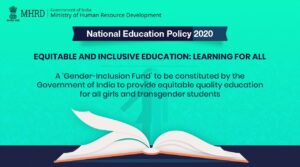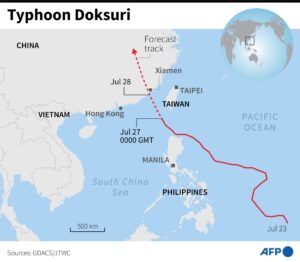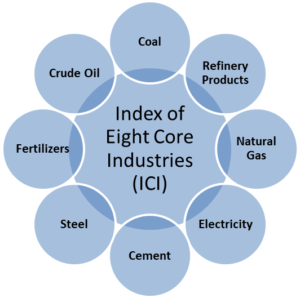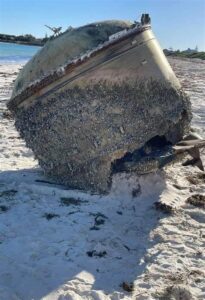Topics:
- Gender Inclusion Fund
- Green Fuel Manufacturing Method
- Rohini Commission
- Typhoon Doksuri
- Core Sector
- ISRO Rocket debris in Australia
Gender Inclusion Fund

Introduction
- The Gender Inclusion Fund is a fund introduced by the National Education Policy (NEP) 2020 to provide quality and equitable education to all girls and transgender students.
- The fund will be available to states to implement priorities determined by the central government critical for assisting these groups in gaining access to education.
- The fund will also support the creation of Special Education Zones for the Socially and Economically Disadvantaged Groups (SEDGs), which include gender, socio-cultural, and geographical identities and disabilities.
Objectives
- The main objectives of the fund are to:
- Build the nation’s capacity to provide equitable quality education for all girls as well as transgender students.
- Promote the growth of girls and transgender students in all levels and streams of education.
- Address the systemic barriers and biases that prevent them from achieving their full potential.
- Ensure their safety, security, health and well-being in educational institutions.
- Foster a gender-sensitive and inclusive learning environment.
Provisions
- The fund will provide various provisions for assisting female and transgender children in gaining access to education through different mechanisms such as:
- Provision of free text-books up to Class VIII to all children.
- Uniforms to all girls, SC, ST children and Below Poverty Line (BPL) children up to class VIII.
- Kasturba Gandhi Balika Vidyalayas (KGBVs) for residential schooling of girls from disadvantaged backgrounds.
- Netaji Subhash Chandra Bose Awasiya Vidyalayas and Hostels for residential schooling of boys from disadvantaged backgrounds.
- Rani Laxmi Bai Atmaraksha Prashikshan (Self defense training to Girls).
- Incinerator & Sanitary Pad Vending Machines for menstrual hygiene management.
- Stipend for CWSN Girls for encouraging their enrolment and retention.
Implementation
- The implementation of the fund requires multiple initiatives and actions, which are to be taken up in a synchronized and systematic manner, by multiple bodies including Ministry of Education, CABE, State/UT Governments, education-related Ministries, State Departments of Education, Boards, NTA, the regulatory bodies of school and higher education, NCERT, SCERTs, schools and HEIs.
- The Department of School Education & Literacy has developed an indicative and suggestive NEP Implementation Plan for School Education, ‘Students’ and ‘Teachers’ Holistic Advancement through Quality Education (SARTHAQ)’ which defines activities, goals, outcomes and timeframe for the implementation of NEP 2020.
- A Review Committee for review of the Implementation of NEP 2020 has been constituted under the chairmanship of Dr. K. Kasturirangan.
- The Centre and States work together to increase the public investment in Education sector to reach 6% of Gross Domestic Product (GDP) at the earliest.
Green Fuel Manufacturing Method
Context
- Researchers have devised a practical approach to produce molecular hydrogen using simple feedstock chemicals, such as methanol, and effectively utilizing the hydrogen to create valuable chemicals and pharmaceuticals.
- The project received support from SERB, an institution attached to the Department of Science and Technology (DST).
Using Ruthenium Complex as a Catalyst
- The scientists utilized a commercially available ruthenium complex as a catalyst, operating under mild conditions, to generate hydrogen from methanol through a clean chemical dehydrogenation reaction.
- They also harnessed the applicability of methanol as a potential transfer hydrogenation agent for the catalytic reduction of various functional compounds.
The Versatility of Methanol as a Hydrogen Carrier
- Methanol proves to be a valuable hydrogen carrier in synthetic organic chemistry due to its ease of storage and transportation compared to free hydrogen.
- This characteristic makes it highly useful in industrial applications.
Opening New Avenues for Bulk and Fine Chemical Production
- The innovative strategy developed by the scientists opens up new opportunities for both fundamental research and industrial applications.
- It enables the production of bulk and fine chemicals, expanding the possibilities of using hydrogen as a clean energy source.

Hydrogen from Methanol: A Cleaner Source of Energy
- Hydrogen is widely considered one of the cleanest sources of energy, especially when obtained from renewable resources such as indigestible biomass or bio-derived alcohols like methanol.
- This method offers a more environmentally friendly and energy-efficient way to generate hydrogen.

- While hydrogen can be obtained from various sources like water and methane, the process of extracting pure hydrogen from them consumes substantial energy.
- Methanol emerges as a potential candidate due to its gravimetric hydrogen content of 12.6% and its efficient conversion to H2 and CO2 as final products.
Aqueous Methanol: Enhancing Transfer Hydrogenation and C1 Chemistry
- Researchers suggest that aqueous methanol holds promise as a potential source for amplifying transfer hydrogenation and C1 chemistry, further enhancing the application of this groundbreaking approach.
Rohini Commission
Context:
- After almost six years and 14 extensions, the commission for subcategorization of Other Backward Classes (OBCs) finally submitted its report on the last day of its tenure.
- The report now puts the decision in the hands of the Modi government, which must consider whether it wants to redefine the reservation structure for backward classes as established by the Mandal Commission.
Formation and Purpose of the Rohini Commission:
- The commission, known as the Rohini Commission, was established under Article 340 of the Indian Constitution with the purpose of examining the issue of subcategorization within OBCs listed in the Central List.
- It was constituted in October 2017 and was initially given 12 weeks to submit its report to the President of India.
- However, the commission received a total of 14 extensions, the last one extending its term until January 31, 2023.
|
Objectives of the Rohini Commission: The commission had three main objectives: 1. Studying the extent of inequitable distribution of reservation benefits among OBC castes listed in the broad category of OBCs and comparing them with those included in the Central List. 2. Developing a scientific approach, including parameters, criteria, norms, and mechanisms, for subcategorization within Other Backward Classes. 3. Identifying respective classes, communities, sub-castes, or synonyms from the Central List of Other Backward Classes and categorizing them into respective subcategories. |
Findings and Recommendations of the Rohini Commission:
After thorough examination, the Rohini Commission proposed a four-category formula for the equitable redistribution of the existing 27% reservation quota for Other Backward Classes.
The key recommendations:
- Category 1: This category comprises 1,674 groups, mainly the most disadvantaged groups, and it is proposed to receive a 2% reservation.
- Category 2: Consisting of 534 caste groups, Category 2 is recommended to have a 6% quota reservation.
- Category 3: This category includes 328 caste groups, and it is suggested to receive a 9% reservation.
- Category 4: Comprising 97 caste groups, Category 4 is proposed to have a 10% reservation.
Ensuring Equitable Distribution:
- The subcategorization proposed by the Rohini Commission ensures that even though Category 4 receives the largest share of reservation (10%), other categories will also be guaranteed their respective shares.
- This move is expected to enhance the fair allocation of reservation benefits among various OBC groups.
Digitization and Standardization:
- In addition to the reservation formula, the Rohini Commission recommended complete digitization of all OBC records and the implementation of a standardized system for issuing OBC certificates.
- These measures aim to streamline the process and make it more efficient.
Conclusion:
The submission of the report by the Rohini Commission marks a crucial step in addressing the subcategorization issue within OBCs.
The government now has the responsibility of reviewing the recommendations and making informed decisions to redefine the reservation structure for backward classes in line with the commission’s proposals.
Typhoon Doksuri

Context:
- Typhoon Doksuri brought a deluge of record-breaking rain to Beijing, China, prompting the evacuation of more than 31,000 people since July 30, 2023.
- The storm’s impact has been severe, necessitating urgent measures to safeguard the affected population.
Key Points:
- Doksuri’s Arrival and Impact on Eastern China:
- Doksuri, classified as China’s sixth typhoon of 2023, made landfall on the eastern seaboard through coastal Fujian province on July 28.
- The storm triggered heavy flooding in the region, leading to significant damage and disruptions.
- Doksuri’s Devastation in the Philippines, Taiwan, and China:
- Initially known as Super Typhoon Egay in the Philippines, Typhoon Doksuri proved to be a formidable tropical cyclone.
- As it progressed, it caused extensive damage and havoc in the Philippines, Taiwan, and China in late July 2023.
- The widespread destruction caused by the typhoon in multiple countries has raised concerns over the region’s resilience to natural disasters.
Core Sector
News: Core Sector Records 5-Month High Growth of 8.2% in June
The output of India’s core sector, comprising eight key infrastructure sectors, saw a significant expansion in June, reaching a five-month high of 8.2%. This growth was primarily driven by a high base effect and positive performances in seven out of the eight sectors.
Sector-wise Growth Rates
- Data released by the Ministry of Commerce and Industry revealed the growth rates for specific sectors in June.
- The output of fertilizers and cement experienced a slight slowdown compared to the previous month, with growth rates of 3.4% and 9.4%, respectively.
- However, the coal sector saw a notable acceleration, achieving a growth rate of 9.8%. Additionally, refinery products, steel, and electricity sectors also recorded impressive growth rates of 4.6%, 21.9%, and 3.3%, respectively.
An Overview of the Core Sector

The core sectors of an economy are crucial industries that significantly impact its overall performance. In the case of the Indian economy, these core sectors include Coal, Crude Oil, Natural Gas, Refinery Products, Fertilizer, Steel, Cement, and Electricity.
Weight in the Index of Industrial Production (IIP)
- These eight core industries collectively contribute more than 40.27% to the Index of Industrial Production (IIP).
- The weightage of each sector in the IIP is as follows, in decreasing order: Refinery Products (28.04), Electricity (19.85), Steel (17.92), Coal (10.33), Crude Oil (8.98), Natural Gas (6.88), Cement (5.37), and Fertilizers (2.63).
The Index of Eight Core Industries (ICI)
- The Index of Eight Core Industries (ICI) is a production volume index prepared and released by the Office of the Economic Adviser (OEA) under the Department for Promotion of Industry and Internal Trade (DPIIT), Ministry of Commerce & Industry, Government of India.
- The ICI is computed every month using the Laspeyres formula, which employs the weighted arithmetic mean of quantity relatives.
- The Laspeyres Index calculates the cost of a group of commodities at current prices, divides it by the cost of the same group at base period prices, and then multiplies the result by 100.
Importance and Usage
- The ICI is a vital indicator used to measure the individual and collective performances of the production in the eight core industries.
- Policymakers, including the Ministry of Finance, other Ministries, and Departments, rely on this index for informed decision-making.
- Furthermore, banks use it to assess financing for infrastructure projects, and the Reserve Bank of India (RBI) also considers the ICI in its evaluations and policymaking processes.
ISRO Rocket debris in Australia
Context: Debris from an ISRO Rocket Found in Australia Raises Concerns about Space Junk

Introduction
Recently, the discovery of a large object on the shores of Western Australia has been confirmed as debris from an ISRO rocket used for the IRNSS constellation. This incident has sparked concerns about space debris and its potential impact on Earth and its inhabitants.
Frequency and Risks of Space Debris
Common Occurrences: Incidents of space debris falling back to Earth are relatively common, but they mostly involve small fragments that do not attract significant media attention.
Publicized Instances:
There have been a few highly publicized cases, such as the 25-tonne Chinese rocket chunk that fell into the Indian Ocean in May 2021 and the disintegration of the Skylab space station in 1979, with some fragments landing in Western Australia.
How did ISRO Debris Land in Australia?
Probable Re-entry and Ocean Drift: The debris likely remained unburnt during re-entry into the atmosphere and eventually fell into the ocean. Ocean currents might have carried it towards the Australian shores.
Move for Disposal: The Australian Space Agency is collaborating with ISRO to determine the next steps, including obligations under the United Nations space treaties.
Potential Hazards and Impact
Threat to Life and Property: Falling space junk poses a threat to life and property. Even objects falling into oceans can risk marine life and contribute to pollution.
Recorded Incidents: There have been no recorded incidents of falling space objects causing significant damage on Earth. Instances of debris falling over land have generally occurred in uninhabited areas.
International Regulations and Liability
- Convention on International Liability for Damage Caused by Space Objects: International regulations, like this Convention, govern issues related to space debris falling back to Earth.
- Absolute Liability: The launching country is “absolutely liable” to pay compensation for any damage caused by its space object on Earth or to a flight in the air.
- Compensation Provision: In the current case, if the PSLV debris had caused any damage in Australia, India could have been liable to pay compensation, regardless of it falling into the ocean first.
- Past Compensation: The Convention has resulted in compensation payment only once when Canada sought damages from the Soviet Union for a satellite with a radioactive substance falling into its uninhabited northern territory in 1978. The Soviet Union paid 3 million Canadian dollars as compensation.
Liability Convention, 1972
Introduction
- The Convention on International Liability for Damage Caused by Space Objects, also known as the Space Liability Convention, is a treaty from 1972 that expands on the liability rules created in the Outer Space Treaty of 1967.
- The treaty defines responsibility in case a space object causes harm. The treaty says that a launching State shall be absolutely liable to pay compensation for damage caused by its space objects on the surface of the earth or to aircraft, and liable for damage due to its faults in space.
- The treaty also provides for procedures for the settlement of claims for damages.
Key Provisions
- States (countries) bear international responsibility for all space objects that are launched within their territory. This means that regardless of who launches the space object, if it was launched from State A’s territory, or from State A’s facility, or if State A caused the launch to happen, then State A is fully liable for damages that result from that space object.
- If two states work together to launch a space object, then both of those states are jointly and severally liable for the damage that object causes. This means that the injured party can sue either of the two states for the full amount of damage.
- Claims under the Liability Convention must be brought by the state against a state.
- The convention was created to supplement existing and future national laws providing compensation to parties injured by space activities.
- Whereas under most national legal systems an individual or a corporation may bring a lawsuit against another individual or another corporation, under the Liability Convention claims must be brought on the state level only.
- This means that if an individual is injured by a space object and wishes to seek compensation under the Liability Convention, the individual must arrange for his or her country to make a claim against the country that launched the space object that caused the damage.
Status
- The Liability Convention was concluded and opened for signature on 29 March 1972. It entered into force on 1 September 1972.
- As of 1 January 2021, 98 States have ratified the Liability Convention, 19 have signed but not ratified and four international intergovernmental organizations have declared their acceptance of the rights and obligations provided for in the Agreement.

